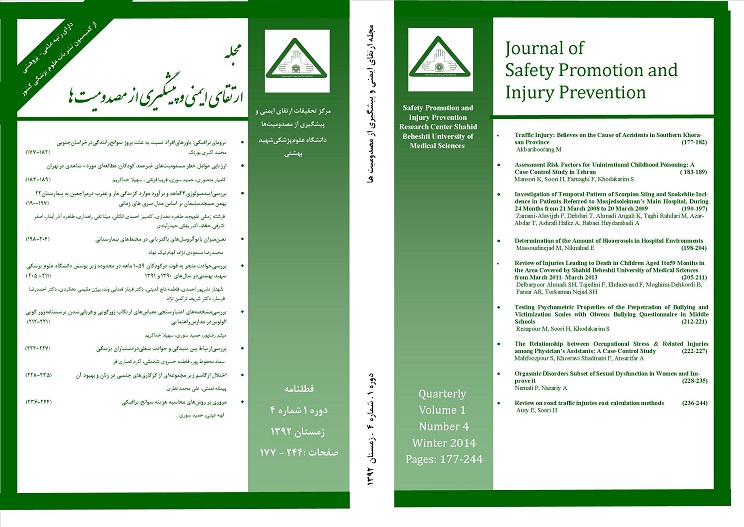...
ارتقای ایمنی و پیشگیری از مصدومیت ها,
دوره 1 شماره 4 (2014),
20 April 2014
,
صفحه 190-197
https://doi.org/10.22037/meipm.v1i4.6094
چکیده
Background and Objective: Scorpion sting and snakebite are the important problems in some area such as Iran that must be addressed. This study was to investigate temporal pattern of scorpion sting and snakebite incidence in patients referred to Masjedsoleiman’s main hospital, during 24 months from 21 March 2008 to 20 March 2009.
Materials and Methods: It was an analytical study to scrutiny of monthly and seasonal procedure of scorpion sting and snakebite. Data were analyzed by SPSS and Minitab. To identify the goodness of fit model for monthly and seasonal incidence of scorpion sting and snakebite, autoregressive integrated moving average (ARIMA) models were used to explore time series analysis.
Results: Of all 9457scorpion sting and snake-bite cases in patients referring to hospital, 45% (n=4253) were men. Mean age of them was 28.26±0.36 years. Significant numbers (27%) of these patients had 21-30 years old, and were bitted in urban (93%), at their home (99.7%). The auto regression suggested that monthly average incidents model have a moving average. The analyses through Anderson- Darling test provide evidence that the distribution of residuals was normal (P= 0.125).
Conclusion: Weather variables can be as the predictors of scorpion sting and snake-bite incidence for Masjedsoleiman.
How to cite this article: Zamani-Alavijeh F, Dehdari T, Ahmadi Angali K, Taghi Rahdari M, Azar-Abdar T, Ashrafi Hafez A, Babaei Heydarabadi A. Investigation of Temporal Pattern of Scorpion Sting and Snakebite Incidence in Patients Referred to Masjedsoleiman’s Main Hospital, During 24 Months from 21 March 2008 to 20 March 2009. Irtiqa Imini Pishgiri Masdumiyat (Safety Promotion and Injury Prevention).2014; 4(1):190-197.
- Scorpion sting
- Snake-bite
- Time Series
- Masjedsoleiman
ارجاع به مقاله
- چکیده مشاهده شده: 602 بار
- PDF (English) دانلود شده: 403 بار
